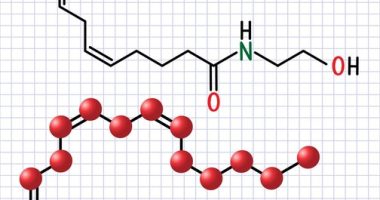Bixin, primarily recognized as a natural colorant derived from the seeds of the annatto tree, has long been valued in the food and cosmetics industries for its vibrant hues. However, recent advances in research have unveiled potential applications of bixin far beyond its traditional uses. A comprehensive review by Rafael Teruiti de Oliveira Takamoto and his team delves into the expanding scope of bixin, exploring its promising roles in fields like Pharmacology, Endocrinology, Oncology, and even in novel food technology applications. The study, which spans publications from 1911 to 2023, focuses particularly on technological advancements that facilitate the use of bixin in health-related areas, including drug delivery systems and the enhancement of lipid-soluble ingredients. Despite bixin’s insolubility in water, innovative solutions have been developed to harness its properties effectively in aqueous environments. This review highlights the significant shift from conventional uses towards groundbreaking health-oriented applications, marking bixin as a compound of increasing scientific interest. Through analyzing a wealth of literature, the researchers reveal both a sustained interest in food technology and a burgeoning exploration into bixin’s therapeutic potential, promising exciting developments in diverse scientific fields.
The annatto tree, from which bixin is extracted, is native to tropical regions of the Americas and has been used by indigenous populations for centuries, primarily as a dye for fabrics but also as a food coloring and component in folk medicine. The vibrant red-orange pigment in bixin, which imparts a distinctive shade to foods and products, arises naturally from carotenoids – a type of antioxidant highly valued for both health-promoting properties and vibrant hues.
The recent review by Rafael Teruiti de Oliveira Takamoto and colleagues offers a timely reevaluation of bixin, correlating historical applications with contemporary scientific findings. With our expanding understanding of carotenoids and their biological roles, researchers are now probing deeper into bixin’s molecular properties and how these can be harnessed for more than just coloration. The focus on new methodologies to improve bixin’s solubility and bioavailability is particularly crucial, as these challenges have historically restricted its application in aqueous solutions and limited its bioactive potential.
Extending into pharmaceutical and medical research, bixin is currently being investigated for its antioxidative, anti-inflammatory, and possibly anticarcinogenic properties. Through innovative drug delivery systems, such as nanoparticle embedding and molecular encapsulation, bixin is being reimagined as a viable therapeutic agent. For instance, its integration into lipid-based delivery platforms could resolve issues related to its insolubility, enhancing its application not only in medicine but also in water-based products like beverages and hygienic products.
Moreover, in the context of nutrition and endocrinology, bixin’s role in modulating lipid metabolism and potentially regulating hormone-related activities offers promising avenues for the treatment and management of lifestyle diseases, such as obesity and diabetes. Researchers are particularly excited about the compound’s intra-cellular signaling capabilities which could be pivotal in understanding and manipulating metabolic pathways.
The research encompassing bixin’s application in oncology is also notable. Studies suggest that bixin may possess properties that can inhibit or slow the progression of cancer cells, thereby providing a natural adjunct treatment with lower toxicity compared to traditional chemotherapy agents.
This re-evaluation of bixin is occurring at a conducive moment when there is a growing trend towards natural and safe additives in the food and cosmetics industries coupled with an urgent need for novel therapeutic agents in the medical field. The comprehensive review by Rafael Teruiti de Oliveira Takamoto’s team not only encapsulates this transition but also systematically sets the stage for future explorative research that could potentially revolutionize how we perceive and utilize this ancient yet persistently intriguing natural compound.
In light of these insights, it becomes clear that the scope for bixin extends well beyond its initial colorant role, aligning with wider health, technological, and environmental dynamics that underpin modern scientific research.
To probe the expanding applications of bixin, Rafael Teruiti de Oliveira Takamoto and his team employed a robust methodology encompassing a systematic literature review that combined both historical analysis and contemporary scientific evaluation. The primary aim was to document the evolution of bixin applications from mere coloration to its potential impacts in health and technology fields, particularly through cutting-edge delivery systems.
The team initiated their study by constructing a comprehensive dataset of literature spanning over a century, from 1911 to 2023. They utilized multiple academic databases such as PubMed, Scopus, and Web of Science, ensuring a broad and inclusive base of sources. Keywords used for the database searches included “bixin,” “annatto,” “carotenoids,” and specific application domains like “pharmacology,” “oncology,” “endocrinology,” and “drug delivery systems.” This strategy ensured the capture of diverse studies relevant to both traditional uses and novel applications of bixin.
Following data acquisition, they conducted a qualitative synthesis of the gathered literature. To systematically analyze and categorize the data, they adopted the PRISMA (Preferred Reporting Items for Systematic Reviews and Meta-Analyses) guidelines, which facilitated a structured and transparent approach. This included criteria for inclusion such as the study must involve bixin explicitly and must relate to the research questions around its health-oriented applications. Exclusions were applied to studies that solely discussed annatto as a food coloring without relating to its bioactive potential.
The team employed a thematic analysis to interpret findings, grouping them into major themes such as ‘Technological Advancements in Bixin Solubility and Bioavailability’, ‘Pharmacological Impacts of Bixin’, ‘Role of Bixin in Endocrinology’, and ‘Bixin’s Oncological Applications’. For each theme, they identified key findings, methodological approaches, and gaps in the current research.
Furthermore, de Oliveira Takamoto’s team employed citation tracking on significant studies to examine the evolution of research attention over time, providing insights into both emerging trends and areas that may have stagnated. This also helped determine the impact of seminal works and any shifts in scientific focus.
To critically assess the literature, they conducted a quality appraisal of the selected studies using established metrics that evaluate research bias, methodological transparency, and the robustness of results. This added a layer of rigor to their review, ensuring that conclusions drawn were based on high-quality evidence.
Finally, the team synthesized their findings into an integrated discussion, linking historical data with current advances to forecast future research trajectories and applications of bixin. They speculated on potential breakthroughs in drug delivery systems, enhanced bioavailability, and non-toxic alternatives to current pharmacological interventions, paving the way for future trials and technical innovations in this field.
Through meticulous exploration of past and present literature, and by organizing their findings around distinct but interrelated thematic lines, de Oliveira Takamoto’s review adeptly set the stage for the revitalized scientific dialogue on bixin’s multifaceted role in both technological and medical realms.
The key findings from Rafael Teruiti de Oliveira Takamoto’s systematic review underscore the multifaceted potential of bixin, particularly highlighting its emergent roles in medical and technological applications. Through their thematic analysis, the team revealed several pivotal areas where bixin shows substantive promise.
**1. Technological Advancements in Bixin Solubility and Bioavailability:**
One of the primary challenges with bixin has been its poor solubility in water, which limits its use in various aqueous-based applications. The review documents innovative approaches that have successfully enhanced the solubility and bioavailability of bixin. Notable among these is the development of nanoparticle-based delivery systems which encapsulate bixin, thereby improving its dispersion in water-based solutions. Such advancements not only pave the way for its potential uses in pharmaceutical formulations but also broaden its application in non-oily food and cosmetic products.
**2. Pharmacological Impacts of Bixin:**
The antioxidative and anti-inflammatory properties of bixin have been well-documented, but recent studies have expanded its pharmacological scope. The review highlights research wherein bixin showed potential as a neuroprotective agent, capable of mitigating oxidative stress-related neurodegeneration. Additionally, its use in managing cardiovascular diseases through the prevention of lipid peroxidation points to its broad therapeutic implications.
**3. Role of Bixin in Endocrinology:**
An intriguing aspect that emerged from the review is bixin’s possible role in endocrinology. Research suggests that bixin can influence lipid metabolism and insulin sensitivity, making it a candidate for the management of metabolic syndromes such as diabetes and obesity. Its potential to modulate hormone levels could also redefine endocrine therapies, offering a natural alternative to synthetic treatments.
**4. Bixin’s Oncological Applications:**
Possibly one of the most promising areas of research into bixin is its role in oncology. The review details studies where bixin demonstrated abilities to inhibit the growth of cancer cells without affecting healthy cells significantly. This selective cytotoxicity, coupled with its low toxicity profile, could make bixin a complementary therapy in cancer treatment, reducing the general toxicity associated with conventional chemotherapy.
**Emerging Themes and Future Directions:**
Besides these specific findings, the review also fostered discussion on broader applications and implications of bixin in health and technology. It prompted speculation on its role in aging, immune response, and even its potential impact on genetic expressions related to chronic diseases. The technological innovations in encapsulating and delivering bixin are also anticipated to revolutionize its commercial utilization, expanding its presence in global markets as both a health supplement and a functional food ingredient.
Through their exhaustive review, Rafael Teruiti de Oliveira Takamoto and his team have not only highlighted the traditional and novel uses of bixin but have also set a robust groundwork for further explorative research. They suggest that future studies should focus on clinical trials to precisely define bixin’s therapeutic efficacy and safety profile, which could speed its integration into medicinal and dietary regimes. The possibility of large-scale applications makes bixin a highly prospective candidate for advancing health technologies, aligning with the global move towards natural and sustainable scientific solutions.
The systematic review conducted by Rafael Teruiti de Oliveira Takamoto and his team opens a new chapter in the scientific exploration of bixin, transforming our perception of this vibrant pigment from a mere colorant to a promising multidimensional agent with substantial applications in health and technology. Their research not only contextualizes bixin within a historical framework but also projects its future trajectory in alignment with modern scientific advancements and societal needs.
**Future Directions in Bixin Research:**
The findings from Takamoto’s review suggest multiple promising avenues for future research that could further delineate the role of bixin in medical and technological fields:
1. **Clinical Trials:**
A significant emphasis should be placed on conducting rigorous clinical trials that could substantiate the therapeutic claims of bixin found in preliminary studies. These trials would be pivotal in determining the efficacy and safety of bixin as a treatment option, thereby facilitating its acceptance in pharmacological and nutritional contexts.
2. **Bioavailability Optimization:**
Continued innovation in nanotechnology and molecular encapsulation should be pursued to improve the solubility and bioavailability of bixin. Research into sustainable and efficient delivery systems can enhance its applicability in water-based products ranging from pharmaceuticals to food and beverages.
3. **Genetic and Molecular Studies:**
Further investigation into the molecular mechanisms of bixin’s actions could offer insights into how it interacts with cellular pathways and genetic expressions. This could lead to breakthroughs in understanding chronic diseases, aging processes, and immune responses.
4. **Environmental and Sustainability Assessments:**
As the demand for natural additives increases, it is crucial to evaluate the sustainability of scaling up annatto cultivation and bixin extraction. Research into the environmental impacts of expanding annatto production, including land use and biodiversity, will be essential.
5. **Interdisciplinary Collaborations:**
Future studies should foster interdisciplinary collaborations integrating pharmacology, oncology, endocrinology, food science, and environmental science to explore bixin’s multifaceted applications holistically.
**Final Thoughts:**
The review by Rafael Teruiti de Oliveira Takamoto is timely and indicative of a larger shift toward exploring natural compounds for their potential beyond traditional usages. By unraveling the complex properties and capabilities of bixin, this work not only contributes to the scientific community but also offers viable, innovative solutions for pressing health issues.
As our society continues to seek safer, more sustainable alternatives to synthetic products in all aspects of life—from medicine to food to cosmetics—the resurgence of interest in natural compounds like bixin becomes increasingly relevant. Takamoto’s comprehensive analysis not only revisits the ancient uses of bixin but adeptly positions it within the frontier of cutting-edge technology and medical research, suggesting a vivid future where natural and science-driven solutions converge.
In conclusion, the ongoing journey to unlock the full potential of bixin is just beginning. With its promising applications across diverse fields, bixin stands as a beacon of the potential inherent in natural products, heralding a new era of biomedical innovation and natural product research that bridges traditional knowledge with modern technological advancements.









